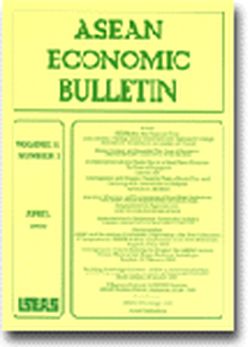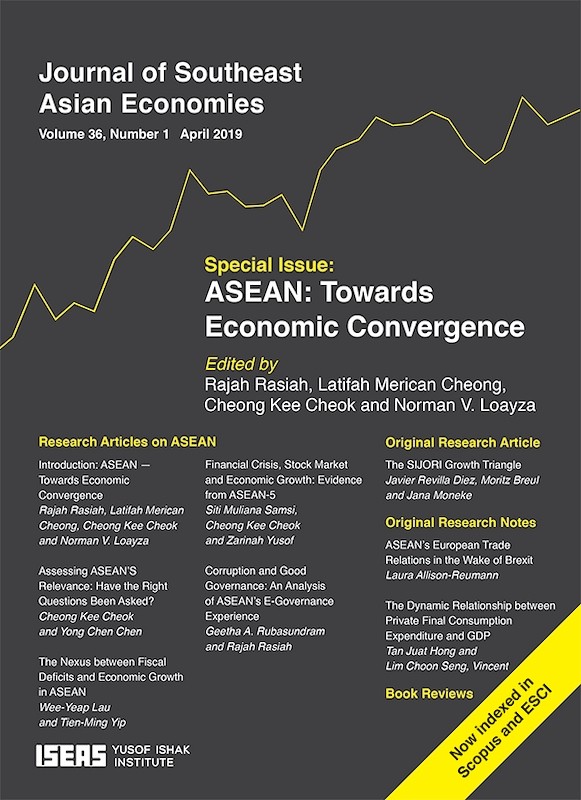ASEAN Economic Bulletin Vol. 20/1 (Apr 2003)

Date of publication:
April 2003
Number of pages:
104
Code:
AE20/1
Contents
-
ASEAN Economic Bulletin Vol. 20/1 (Apr 2003)
-
Preliminary pages
- ARTICLES
-
Singapore Business Cycles: A Supply-Side Analysis, by Choy Keen Meng, author see abstractThis article employs a vector autoregression (VAR) model to investigate the supply-side causes of business cycles in the small open economy of Singapore. The supply shocks examined are oil price, foreign technology, labour supply, productivity, and wage shocks. The empirical results suggest that external and domestic technology shocks are responsible for the bulk of short-term output movements, while labour supply shocks are more important in the long run. In contrast, oil price and wage disturbances play negligible roles in macroeconomic fluctuations. These findings support the view that Singapore business cycles are caused by both domestic and international factors.
-
International Disturbances and Domestic Macroeconomic Fluctuations in Malaysia, by Mansor H Ibrahim, author see abstractThis article analyses international influences, as represented by U.S. macroeconomic variables, on economic fluctuations in a small open economy, Malaysia. The analysis is based on variance decompositions and impulse-response functions generated from a vector auto-regressive model. The results indicate that shocks in U.S. real activity and monetary policy are transmitted to Malaysian real activity. Additionally, apart from domestic monetary influences on Malaysian inflation, evidence for the lagged transmission of U.S. inflation to Malaysian inflation is found. The results highlight the central role played by exchange rates in explaining domestic macroeconomic fluctuations, and more specifically, our results point towards contractionary and inflationary currency depreciation shocks. Exchange rate depreciation also leads to monetary expansion. Thus, since the exchange rate responds to U.S. real output and inflation, exchange rate changes may be viewed as an important channel of shock transmissions to the Malaysian economy. From a policy point of view, these results stress the importance of exchange rate stability for the Malaysian economy.
-
ASEAN-China Free Trade Area: Advantages, Challenges, and Implications for the Newer ASEAN Member Countries, by Thitapha Wattanapruttipaisan, author see abstractChina's accession to the World Trade Organization and the proposed ASEAN-China Free Trade Agreement will provide greater market access in resource- and agro-based products and some manufactured goods for the ASEAN-4 countries (Cambodia, Laos, Myanmar, and Vietnam). At the same time, there will be much greater competition from China in both ASEAN-4s home and third-country markets, especially in a wide range of labour- and technology-intensive manufactures. Special and differential (S&D) treatment and flexibility for the ASEAN-4 will be necessary to enable a more effective participation by the newer members in the proposed ASEAN-China FTA. In this connection, two proposals are made for enhancing domestic entrepreneurship and inter-firm networking, and for monitoring and benchmarking supply capabilities and competitiveness at the enterprise level within ASEAN and China.
-
Convergence and its Implications for a Common Currency in ASEAN, by Kraiwinee Bunyaratavej, Eugene D Hahn, authors see abstractThe successful introduction of the euro brings renewed interest to the topic of whether similar approaches might be successfully implemented in other regions. One region that may be a promising candidate for this process is Southeast Asia, comprising the ASEAN member countries. These nations have long seen the value of co-operation in order to promote peace, stability, and economic growth. Nonetheless, important differences between the euro area and the ASEAN zone suggest that a wholesale importation of the European approach may be inopportune at the moment. The issues are examined by using economic convergence modelling perspectives. In general, the findings clearly suggest that further work remains before ASEAN will be able to fully benefit from having a single currency area.
-
An Analysis of Trade Flows between Brunei Darussalam and the European Union, by Kwabena A Anaman, Lujaina H S Al-Kharusi, authors see abstractThis article analyses merchandise trade flows between Brunei Darussalam and the fifteen members of the European Union (EU) over a thirty-five-year period from 1966 to 2000, to identify significant factors influencing the levels of imports and exports between Brunei and each of the fifteen members of the EU. This analysis indicated that there were considerable fluctuations in the values of exports and imports between Brunei and the EU. However, there was a persistent negative balance of trade for Brunei throughout this period. Bilateral trade flows (both imports and exports) between Brunei and the EU members were driven mainly by the populations of Brunei and the EU countries, and the historical relationship of a few EU countries with Brunei and the Borneo region.
-
Southeast Asian Stock Market Linkages: Evidence from Pre- and Post-October 1997, by Kevin James Daly, author see abstractThis article investigates both the static and dynamic interdependence of the stock markets of Indonesia, Malaysia, the Philippines, Singapore, Thailand, and the advanced stock markets of Australia, Germany, and the United States. Using data from 1990 to 2001, the paper employs both correlation and co-integration analysis to describe the behaviour of the above markets, both before and after the 1997 Asian financial crisis. Examination of stock market returns, using correlation analysis, reveals an increase in the interdependencies (increased correlation) across the Southeast Asian stock markets in the aftermath of the crisis. Both multivariate and pairwise co-integration tests are carried out for all the above stock markets. Although there is evidence of integration between the Southeast Asian stock markets, overall the results suggest that there has been no significant increase in the integration between the Southeast Asian stock markets during the post-crisis period. With a few exceptions, there is little evidence to indicate the existence of any co-integrating vectors in either the multivariate or pairwise co-integration tests.
-
BOOK REVIEW: Migrant Workers in Pacific Asia, edited by Yaw A. Debrah, by Prema-Chandra Athukorala, author
-
BOOK REVIEW: Exploring Indo-ASEAN Economic Partnership in Globalizing World, by Atul Sarma and Pradeep Kumar Mehta, by Mukul G Asher, author
-
BOOK REVIEW: Small-Scale Enterprises in Developing and Transitional Economies, edited by Homi Katrak and Roger Strange, by Edgard R Rodriguez, author
-
BOOK REVIEW: The Role of SMEs in National Economies in East Asia: Studies of Small and Medium Sized Enterprises in East Asia, vol. II, edited by Charles Harvie and Boon Chye Lee, by Henry Sandee, author
-
BOOK REVIEW: Globalization and Its Discontents, by Joseph Stiglitz, by Paul Vandenberg, author
-
BOOK REVIEW: Globalization and the Asia Pacific Economy, edited by Kyung Tae Lee, by Natalia T Tamirisa, author
-
BOOK REVIEW: Economic Crisis Management: Policy, Practice, Outcomes and Prospects, edited by Tran Van Hoa, by Sakulrat Montreevat, author





